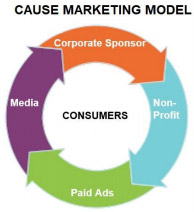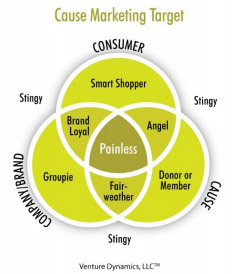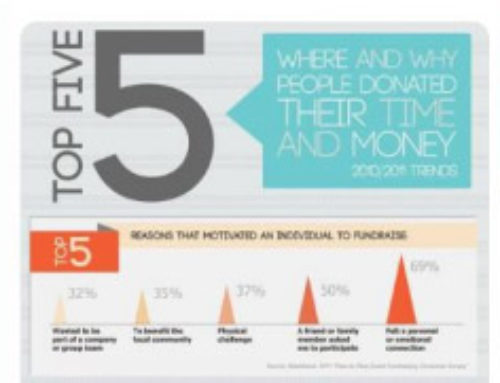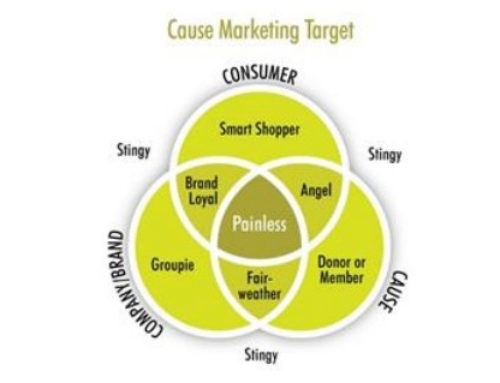A decade ago if you dropped the phrase “cause-related marketing” in your conversation with a colleague, they would most likely return an empty stare. This is clearly not the case today as broadcast outlets, non-profits and corporations jump on the cause-related marketing (CRM) bandwagon.
In 1983, American Express pioneered the CRM movement by donating a part of their customers’ charge card receipts to refurbishment of the Statue of Liberty. While it was a very successful program, it lasted only a few months, offered limited opportunity to build the brand and create enduring relationships with customers.
 “Cause-related promotion and strategic cause-related marketing are no longer synonymous,” points out Carol Cone, a leading authority on the subject. “Cause-related promotion is a tactic used to spike sales quickly and give image a short-lived boost. Cause-related marketing has become part of a company’s core business strategy and is directly tied to a range of business functions,” she observes.
“Cause-related promotion and strategic cause-related marketing are no longer synonymous,” points out Carol Cone, a leading authority on the subject. “Cause-related promotion is a tactic used to spike sales quickly and give image a short-lived boost. Cause-related marketing has become part of a company’s core business strategy and is directly tied to a range of business functions,” she observes.
Defining cause-related marketing is not easy because there are various models, various participatory roles each partner can bring to the table, and it often gets confused with social issues marketing, a broader field of endeavor. Jonathan Polansky, formerly with the Public Media Center in San Francisco, provides a definition that is as good as any of the classic text books on the subject.
“Cause marketing requires an agreement between a non-profit and a for-profit. The deal is struck to maximize perceived benefits to each partner.
The for-profit partner is looking to:
- Associate its product with a perceived social good and thus boost its appeal to a defined market segment which shares that perception
- Increase a broader market segment’s perception of the enterprise as socially engaged or responsible
- Derive bottom-line benefits from increasing market share in the targeted segment.”
Broadcaster’s Role
 The broadcaster’s role in this creative partnership can vary but usually centers around local campaigns developed by stations in cooperation with non-profits which provide program support such as expertise on the issue, spokespersons, on-air materials and manpower for local follow-up or community events.
The broadcaster’s role in this creative partnership can vary but usually centers around local campaigns developed by stations in cooperation with non-profits which provide program support such as expertise on the issue, spokespersons, on-air materials and manpower for local follow-up or community events.
In another model, the broadcaster may air national “public service” messages that have a corporate tie-in which air as paid commercials. However, because the airtime is paid for, the non-profit gets much better placement and frequency than it would otherwise get. Given this win-win-win situation among all the parties involved in cause-related marketing campaigns, there appear to be no downside risks to such arrangements.
However, before entering into a CRM partnership there are some issues that all participants need to think through very clearly.
For example, in many cause marketing relationships, broadcasters are asked to air news pieces on a particular issue which could violate the separation policy most stations have between their advertising and news departments.
This was the case with WHAS-TV in Louisville, KY, which aired a 15-part news series on colorectal cancer which encouraged viewers to pick up a test kit at their local Kroger store. Jean West, the station’s health reporter, was asked to deliver the line as part of her on-air reporting duties, and “I really resented it,” she says, “the project seemed so commercial.”
 According to another expert on developing cause marketing programs, Jerry Wishnow of the Wishnow Group, “Working with broadcasters, particularly when the news department is involved with a CRM project can be tricky,” he said.
According to another expert on developing cause marketing programs, Jerry Wishnow of the Wishnow Group, “Working with broadcasters, particularly when the news department is involved with a CRM project can be tricky,” he said.
“The news director is the emperor of his domain and has the final word on what goes on the air. I try to find a news hook for the particular issue…perhaps it’s a series of investigative reports on the problem, a special feature involving the news staff, or using the station’s on-air reporter as spokesperson for the PSAs we produce. Another technique is to see if we can get PSAs aired adjacent to the news. The goal is to find a way for all the parties in the project to get what they need and want from the relationship.”
Public Perceptions
 An article in the Non-Profit Times, indicated that non-profits are “expressing concern” about public perceptions of product endorsement deals. Some years ago, the American Cancer Society signed a $3 million agreement with Smith-KlineBeecham to promote the Nico-Derm anti-smoking patch. While there is often a fine-line separating endorsement of a product and “educational partnerships,” Steve Dickenson, a spokesman for ACS at the time, commented on their role by saying, “We are involved in a joint partnership of awareness and education. We are not endorsing it [the patch] specifically; therefore, there is no liability on ACS for the product itself.”
An article in the Non-Profit Times, indicated that non-profits are “expressing concern” about public perceptions of product endorsement deals. Some years ago, the American Cancer Society signed a $3 million agreement with Smith-KlineBeecham to promote the Nico-Derm anti-smoking patch. While there is often a fine-line separating endorsement of a product and “educational partnerships,” Steve Dickenson, a spokesman for ACS at the time, commented on their role by saying, “We are involved in a joint partnership of awareness and education. We are not endorsing it [the patch] specifically; therefore, there is no liability on ACS for the product itself.”
Jim Bausch, formerly president of the New York-based National Charities Information Bureau has another view, however, and worries about whether the ACS’s action will undermine its reputation and affect public confidence. “I understand the pressure because money is tight, but suppose a better product comes along and if the ACS signed an exclusive arrangement, they are stuck with a product that might be OK but perhaps less than good.”
An article written by Martin Cohen, a lawyer specializing in promotion law titled: “Partner With Charities, But Follow the Rules,” points out some of the pitfalls of cause marketing.
“As with any advertising promotion, the commercial business (corporate sponsor) must comply with a variety of state laws. The mere act of associating with a charity will not result in an exemption of accommodation for the for-profit entity,” Cohen said. “In many states, undertaking a commercial co-venture exposes the corporation to additional legal requirements.”
And, Mr. Cohen went on to say, “what makes cause marketing arrangements even more complex is these laws vary by jurisdiction; there is no single policy to guide commercial ventures that is subscribed to by all states.”
Still another problem is presented among government entities which are aggregately involved in dozens of social issues marketing programs on subjects ranging from health to taxes. Legally, it is difficult if not impossible for most government agencies to enter into cause marketing relationships that could give exclusive arrangements to a corporate sponsor. Thus, many government agencies with an important story to tell about many social issues may not be able to communicate as effectively as those in the private sector with access to corporate funds.
Mission Relevancy
Most of the experts in the field concur that the key to developing a successful CRM partnership is the link between the non-profit organization’s mission and the product or service being promoted.
Professor Harvey Dale, director of the National Center on Philanthropy and Law at New York University’s law school said “the phrase ‘selling out’ is more emotional than objective. If a charity is doing good work and needs money and if it can find a way of getting it other than as a passive recipient through gifts, then it can be a good thing. The question is how appropriate is the cause or the sponsorship to their mission,” he said.
NORTH AMERICAN SPONSORSHIP SPENDING

Growth of CRM
The latest Cone/Porter Novelli Purpose Study, shows a number of trends that demonstrate the increased interest in cause-related marketing programs:
- 78 percent of Americans believe companies should not just make money. They must positively impact society as well.
- 77 percent feel more connected to companies that care about social and environmental issues.
- 66 percent would change their buying habits by switching to products from a socially conscious company.
- 68 percent want to share content about CSR-driven companies with their social networks much more than about traditional companies.
- 54% of Americans bought a product associated with a cause in the past 12 months, a 170% increase
- When price and quality are equal, 89% of consumers report that they would be likely to switch to a brand associated with a good cause, a 23 percent increase over the previous survey.
- 54% of those surveyed bought a product with a social benefit; 65% made a donation; and 42% boycotted a company because they thought it behaved irresponsibly.
No one who is knowledgeable expects the growth of CRM to do anything but continue
an upward path in the future as the line continues to blur between classic product
advertising and social issues marketing.
As referenced earlier, IEG is the major entity which partners with top brands to develop
partnerships between organizations and events throughout sports, arts, entertainment,
associations and causes—for mutual benefit.
As broadcasters and non-profits look for new revenue sources and as the benefits of
these collaborative relationships are recognized the field is expected to grow
dramatically, because it can provide important strategic benefits to all participants.
However, the one thing that everyone can agree on is that developing a successful
partnership depends on very careful scrutiny of the cause, the corporate sponsorship
and how both relate to the long-term mission of the non-profit







Leave A Comment